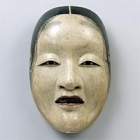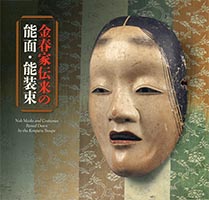Japanese Gallery (Honkan) Rooms T1 & T2
January 31, 2017 (Tue) - March 26, 2017 (Sun)
Long ago, Noh theater was performed at religious events at Shinto shrines and Buddhist temples. In the 14th century, for example, what would later be called the Kanze, Hosho, Konparu, and Kongo troupes performed at Kasuga Shrine and Kofukuji Temple. To this day, the lead roles in Noh plays are performed by actors from these troupes, with the Konparu boasting the longest history.
In the 15th century, Konparu Zenchiku, an actor from this troupe, became the son-in-law of Zeami, who is credited with perfecting Noh theater. Consequently, Zenchiku inherited Zeami’s books of secret Noh teachings. Thereafter, around the late 16th century, Konparu Yasuteru received the patronage of the warlord Toyotomi Hideyoshi, bringing the Konparu troupe to a peak of popularity. However, the troupe subsequently began to lose its vitality, and during a time of upheaval in the late 19th century, many of its masks and costumes were sold and became scattered throughout Japan.
However, one private group, the Teirakusha in Nara, aided the troupe by purchasing many of its objects and allowing the troupe to continue to use them. After the Second World War, 47 Noh masks and 196 costumes in the group’s possession became part of the Tokyo National Museum collection. The masks include very old ones that were created before standardized forms became the norm, as well as famous ones that were copied throughout the ages. Moreover, the Noh costumes from the Azuchi-Momoyama period were created with the latest techniques and the best materials, and are thought to have been gifted to the troupe by the warlord Hideyoshi.
This thematic exhibition is the very first to bring together exceptional masks and costumes of the Konparu troupe. We invite visitors to enjoy this collection, which is prized for its significance in the history of Noh theater.


